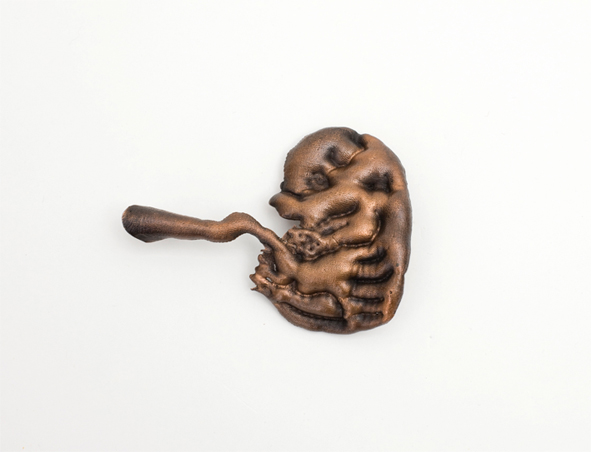What happens when a Mouse Breeds with a Tiger
by Ashley Crawford
Tyger! Tyger! burning bright
In the forests of the night,
What immortal hand or eye
Could frame thy fearful symmetry?
– William Blake: The Tyger (from Songs Of Experience)
What happens when a mouse breeds with a tiger? And, in this day and age, is this such a ridiculous question? On the good side, both creatures are classified as Mammalia, but that’s about where the luck runs out. A tiger falls under the order of Carnivora, whilst a mouse heralds from Rodentia. Both find homes in the jungle, but mice are also inclined to shelter in your walls. Life becomes a little tricky when you’re laying a trap for a Mousetiger – you can’t use a mouse for bait – that would be a form of intra-species cannibalism and of course cheese is far from a tiger’s favourite feast.
But it gets worse. These aren’t even Carnivora. They are based on the extinct Tasmanian Tiger – more marsupial than mammal and a creature grossly misrepresented by early Colonial artists, a fiction even before extinction. And, to make it worse still, there’s a chilling aspect of reality here – Australian scientists have in fact managed to inject thylacine DNA into a mouse foetus, leading to the resurrection of thylacine cartilage.
These are the kind of problems that Caroline Rothwell has to worry about in her laboratory. The lab is in fact comprised of converted bathroom and kitchen in Sydney’s inner suburbs, where vats of polyvinyl chloride bubble maliciously.
Polyvinyl chloride (PVC) is just one of many materials Rothwell utilises to create her hybrids, but this is perhaps apt given that one source of the origins of the Chimaera trails back to the Lycian Way in southwest Turkey where vents in the earth emit burning methane into the air. Chemists use PVC to funnel methane. Rothwell uses PVC to funnel ideas.
For time immemorial humans have tinkered with nature in the telling of stories. They have grafted humans onto fish – the Mermaid; and horses – the Minotaur. A lion sprouts a snake or a scorpion as its tail as the Manticore. The oceans and remote islands crawl with the malformed and the bizarre, worlds that Aristotle dubbed “ho exo topos” – essentially the “outside world” – the world explored by H.G. Wells in his 1896 novel The Island of Doctor Moreau and almost 100 years later by David Cronenberg in his 1986 re-make of The Fly.
This is also the world of Caroline Rothwell, a place where the rational, scientific mind meets the irrational, rampant imagination. In the past she has created strange, inflatable black islands that seemed to throb with life and gothic hints of turrets and fortifications. In her Lexicon series Rothwell has begun to forest her environs, the gnarled results resembling the shadows of a post-nuclear blast. These are Newton’s rationalist trees – gravity – and Darwin’s Tree of Life – evolution – meeting the Hebrew Tree of Knowledge – belief.
Here we see the Moustiger as a wee embryo, a strange little creature, its’ distended umbilical cord preparing to coil around the body. Grown up, these creatures have much in common with the Ouroboros, the mythical self-consuming snake or dragon that eats its own tail. The legend of the Ouroboros suggested cycles that begin anew as soon as they end, an eternal self-consumption.
Rothwell is creating her own world, a world that fluctuates between solidity and an amorphous vulnerability. She invites her viewers into this alternate reality fully aware that we will be thrown off-balance by her bizarre menagerie, by her peculiarly deformed flora and fauna. She is rewriting Charles Darwin’s Origin of The Species with a surrealist scalpel into a kind of repellant science fiction.
One of the strange joys of Rothwell’s work is it’s shape-shifting in terms of categorization. For her 2008 Artspace exhibition writer Christine Morrow argued well for her works as “monuments” and of course the massive Blowback sculpture in that show, also exhibited at Tolarno Galleries in Melbourne, was indeed monumental. Elsewhere writers have argued the influence of colonialism on Rothwell’s work, and indeed, she has been inspired at times by the Colonials – her 2006 site-specific work Terminus was inspired in part by a 1793 drawing of Sydney Cove by convict artist Thomas Watling. In 2008 she was curated into the massive neo goth – back in black exhibition at the University of Queensland Art Museum, thus placing her within the realm of the Gothic.
But such catgorisations: the “Monument,” the “Colonial” and the “Gothic” while relevant, all collapse under the weight of evidence. Her Monuments have the ability to deflate and tend to throb with ventilated air, tendencies far removed from the usual notions of a granite or marble monument. Like Watling, whose depictions of Australia had more in common with Sussex than Sydney, her works are essentially fictions, but at least Watling was rooted in more ‘normal’ depictions of nature. It is also not hard to see Rothwell’s work as ‘gothic’ with its’ taste for the macabre.
But one could also read her work as political, a commentary on the current environmental meltdown (Blowback, for instance, is a term for catastrophic secret ops). Or they could be a commentary on genetic engineering gone awry.
Or perhaps these creatures, this flora and fauna, have simply adapted to survive within Rothwell’s feverish imagination. The native white heron has grown four legs and extra heads to traverse Rothwell’s world. The mouse has indeed inter-bred with the tiger to forage these strange lands. Neither apocalyptic nor Utopian, this is exo topos – a world related to, but simultaneously far removed, from our own. A world of strange beauty and bewildering wonderment.



